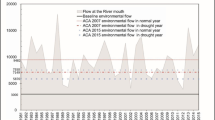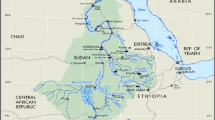Abstract
This paper focuses on assessing a policy for reallocation of Colorado River water for major stakeholders in the state of California, to set a standard for sustainable long-term public and environmental use. We address the policy of allocating scarce water resources to competing stakeholders of different sectors in the Salton Sea region under over-committed water rights agreement. We determine the value of water applied to the agricultural, urban and tourist sectors to estimate the regional welfare under different allocation frameworks. We use two models for allocation: one involving a social planner approach that maximizes regional welfare, the second focusing on the bankruptcy rules of proportional deficit (cutback), and constrained equal award. We find the proportional cutback framework to be less conducive to regional welfare, although it presents a more politically feasible and robust option.






Similar content being viewed by others
Data Availability
All data can be made available upon request from the corresponding author.
Notes
We recognize that by referring only to recreational benefits from the Salton Sea we ignore several important aspects associated with water level in the Sea, such as health impacts.
Based on BLS (2019) inflation between 1960 and 2017 was 724 percent, and between 2011 and 2017 it was 10 percent.
It should be noted that the value of unit of water in the agricultural sector is very low for consumption above nearly 125,000, 300,000, and 60,000AF for IID, CVWD, and SDCWA, respectively.
Note that the value of unit of water in the urban sector is very low for consumption above nearly 447,000, 147,000, and 303,000AF for MWD, CVWD, and SDCWA, respectively.
References
Acquah S, Ward FA (2017) Optimizing adjustments to transboundary water sharing plans: A multi-basin approach. Water Resour Manag 31(15):5019–5042. https://doi.org/10.1007/s11269-017-1794-3
Aumann RJ, Maschler M (1985) Game theoretic analysis of a bankruptcy problem from the Talmud. J Econ Theory 36:195–213
Bithas K, Stoforos C (2006) Estimating urban residential water demand determinants and forecasting water demand for Athens metropolitan area, 2000–2010. S East Eur J Econ 4(1):47–59
Booker JF, Young RA (1994) Modeling intrastate and interstate markets for Colorado River water resources. J Environ Econ Manag 26(1):66–87
Branzei R, Ferrari G, Fragnelli V, Tijs S (2008) A flow approach to bankruptcy problems. AUCO Czech Econ Rev 2(2):146–153
Brown TC, Mahat V, Ramirez JA (2019) Adaptation to future water shortages in the United States caused by population growth and climate change. Earths Future 7:219–234
Bureau of Labor Statistics (BLS) (2019) CPI Inflation Calculator. (n.d.). Retrieved from https://data.bls.gov/cgi-bin/cpicalc.pl
Burger DW, Hartin JS, Hodel DR, Lukaszewski TA, Tjosvold SA, Wagner SA (1987) Water use in California ornamental nurseries. California Agriculture, pp 7–8
Clyde SE (2008) Marketplace reallocation in the Colorado River Basin: Better utilization of the West’s scarce water resources. J Land Resour Environ Law 28(1):49–70
Crespo D, Albiac J, Kahil T, Esteban E, Baccour S (2019) Tradeoffs between water uses and environmental flows: A hydroeconomic analysis in the Ebro Basin. Water Resour Manag 33(7):2301–2317. https://doi.org/10.1007/s11269-019-02254-3
Degefu DM, He W, Min YL, Qi AZ (2018) Bankruptcy to surplus: Sharing transboundary river basin’s water under scarcity. Water Resour Manag 32(8):2735–2751
Degefu DM, He W (2016) Allocating water under bankruptcy scenario. Water Resour Manag 30(11):3949–3964
Dinar A, Dinar S (2017) International water scarcity and variability: Managing resource use across political boundaries. University of California Press, Oakland
Dinar S, Katz D, De Stefano L, Blankespoor B (2015) Climate change, conflict and cooperation: Global analysis of the effectiveness of international river treaties in addressing water variability. Polit Geogr 45:55–66
Dziegielewski B, Optiz E (1991) Municipal and industrial water use in the Metropolitan Water District service area, Interim Report No. 4. Prepared for The Metropolitan Water District of Southern California. Planning and Management Consultants, Ltd., Carbondale, IL, Los Angeles
Esteban E, Dinar A (2015) The role of groundwater-dependent ecosystems in groundwater management. Nat Resour Model 29(1):98–129
García-Navarro MC, Evans RY, Montserrat RS (2004) Estimation of relative water use among ornamental landscape species. Sci Hortic 99(2):163–174
Griffin RC, Mjelde JW (2000) Valuing water supply reliability. Am J Agric Econ 82(2):414–426
Iamtrakul P, Hokao K, Kardi T (2005) Public park valuation using travel cost method. Proc East Asia Soc Transp Stud 5:1249–1264
Imperial, County, Office of the Agricultural Commissioner Sealer of Weights & Measures (2018) 2017 Annual crop report. El Centro, CA
Jenkins MW, Lund JR, Howitt RE (2003) Using economic loss functions to value urban water scarcity in California. Am Water Works Assoc 95(2):58–70
Kahil MT, Dinar A, Albiac J (2016) Cooperative water management and ecosystem protection under scarcity and drought in arid and semiarid regions. Water Resour Econ 13:60–74
Klein CA (2012) Water bankruptcy. Minn Law Rev 97:560–624
Liu J et al (2017) Water scarcity assessments in the past, present, and future. Earths Future 5:545–559. https://doi.org/10.1002/2016EF000518
Madani K, Dinar A (2013) Exogenous regulatory institutions for sustainable common pool resource management: Application to groundwater. Water Resour Econ 2–3:57–76
Madani K, Zarezadeh M, Morid S (2014) A new framework for resolving conflicts over transboundary rivers using bankruptcy methods. Hydrol Earth Syst Sci 18:3055–3068
McCabe GJ, Wolock DM, Pederson G, Woodhouse CA, McAfee S (2017) Evidence that recent warming is reducing upper Colorado River flows. Earth Interactions 21:Paper No. 10
MWD (Metropolitan Water District of Southern California (2018) The Metropolitan Water District of Southern California Annual Report for the Fiscal Year July 1, 2017 to June 30, 2018. Metropolitan Water District. www.mwdh2o.com/PDF_Who_We_Are/2018_AnnualReport.pdf. Accessed 18 Mar 2020
Mianabadi H, Mostert E, Zarghami M, van de Giesen N (2014) A new bankruptcy method for conflict resolution in water resources allocation. J Environ Manag 144:152–159
Nigatu G, Dinar A (2015) Economic and hydrological impacts of the Grand Ethiopian Renaissance Dam on the Eastern Nile River Basin. Environ Dev Econ 21(4):532–555
O’Neill B (1982) A problem of rights arbitration from the Talmud. Math Soc Sci 2:345–371
Oftadeh E et al (2016) Evaluation of the bankruptcy approach for water resources allocation conflict resolution at basin scale: Iran’s Lake Urmia experience. Water Resour Manag 30(10):3519–3533
QSA Water Conservation and Transfer Agreeement Implementation Report (2015) Imperial Irrigation District. https://www.iid.com/home/showdocument?id=14243. Accessed 20 Mar 2020
Read L, Madani K, Inanloo B (2014) Optimality versus stability in water resource allocation. J Environ Manag 133:343–354
Rightnar J, Dinar A (2019) Bankruptcy allocation of the colorado river water: The iImpact of river flow deficit on Tthe salton sea region and re-allocation policies to address it. UCR SPP working paper series, WP# 19-02. https://spp.ucr.edu/sites/g/files/rcwecm1611/files/2019-10/wp%231902.pdf. Accessed 12 May 2020.
Schwabe KA, Schuhmann PW, Baerenklau KA, Nergis N (2008) Fundamentals of estimating the net benefits of ecosystem preservation: The case of the Salton Sea. Hydrobiologia 604(1):181–195
Sechi GM, Zucca R (2015) Water resource allocation in critical scarcity conditions: A bankruptcy game approach. Water Resour Manag 29(2):541–555
Shenlin L, Yanhu H, Xiaohong C, Zheng Y (2020) The improved bankruptcy method and its application in regional water resource allocation. J Hydro Environ Res 28:48–56
Stern CV, Sheikh PA (2019) Management of the Colorado River: Water allocations, drought, and the federal role. Congressional Budget Service, Paper R45546 Updated May 17, 2019
Tourism Economics (2014) The potential economic impact of the Salton Sea on the greater Palm Springs tourism industry (Report). Greater Palm Springs Convention & Visitors Bureau. https://assets.simpleviewinc.com/simpleview/image/upload/v1/clients/palmsprings/salton_sea_eis_ff17089f-eed9-4619-a89f-df859da583dc.pdf. Accessed 20 Mar 2020
United States Geological Survey (2007) The USGS Salton Sea Science Office: https://pubs.usgs.gov/fs/2007/3097/. Accessed 18 Mar 2020
University of California Cooperative Extension Imperial County (2018) Guidelines to production costs and practices Imperial County. El Centro, CA UC Cooperative Extension
University of California Cooperative Extension Riverside County (2018) Guidelines to production costs and practices Riverside County. Riverside, CA UC Cooperative Extension
University of California Cooperative Extension San Diego County (2018) Guidelines to production costs and practices San Diego County. CA UC Cooperative Extension, San Diego
U.S. Department of the Interior (n.d.) Drought in the Colorado River Basin. https://www.doi.gov/water/owdi.cr.drought/en/. Accessed 18 Mar 2020
Young RA, Loomis JB (2014) Determining the economic value of water: Concepts and methods, Second. Edition RFF Press and Routledge, New York
Acknowledgements
This paper is based to a large extent on the capstone project submitted by Jacob Rightnar to the University of California, Riverside, School of Public Policy on June 7, 2019, under the supervision of Ariel Dinar. Support from the W4190 Multistate NIFA-USDA-funded project, Management and Policy Challenges in a Water-Scarce World is greatly appreciated.
Funding
No funding from external sources was used for the work leading to this paper.
Author information
Authors and Affiliations
Corresponding author
Ethics declarations
Conflicts of Interest
No Conflict of Interest.
Code Availability
Excel Macro can be made available upon request from the corresponding author.
Additional information
Publisher's Note
Springer Nature remains neutral with regard to jurisdictional claims in published maps and institutional affiliations.
Electronic supplementary material
ESM 1
(DOCX 335 kb)
Rights and permissions
About this article
Cite this article
Rightnar, J., Dinar, A. The Welfare Implications of Bankruptcy Allocation of the Colorado River Water: The Case of the Salton Sea Region. Water Resour Manage 34, 2353–2370 (2020). https://doi.org/10.1007/s11269-020-02552-1
Received:
Accepted:
Published:
Issue Date:
DOI: https://doi.org/10.1007/s11269-020-02552-1
Keywords
- Colorado River water
- Salton Sea
- Water scarcity
- Bankruptcy allocation
- Regional welfare
- Sectoral equity
- Social planner




